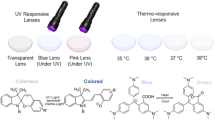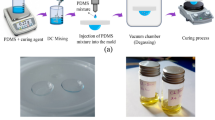Abstract
Light-mediated therapeutics have attracted considerable attention as a method for the treatment of ophthalmologic diseases, such as age-related macular degeneration, because of their non-invasiveness and the effectiveness to ameliorate the oxidative stress of retinal cells. However, the current phototherapeutic devices are opaque, bulky, and tethered forms, so they are not feasible for use in continuous treatment during the patient’s daily life. Herein, we report wireless, wearable phototherapeutic devices with red light-emitting diodes for continuous treatments. Red light-emitting diodes were formed to be conformal to three-dimensional surfaces of glasses and contact lenses. Furthermore, fabricated light-emitting diodes had either transparency or a miniaturized size so that the user’s view is not obstructed. Also, these devices were operated wirelessly with control of the light intensity. In addition, in-vitro and in-vivo tests using human retinal epithelial cells and a live rabbit demonstrated the effectiveness and reliable operation as phototherapeutic devices.

Similar content being viewed by others
References
Kim, J.; Salvatore, G. A.; Araki, H.; Chiarelli, A. M.; Xie, Z. Q.; Banks, A.; Sheng, X.; Liu, Y. H.; Lee, J. W.; Jang, K. I. et al. Battery-free, stretchable optoelectronic systems for wireless optical characterization of the skin. Sci. Adv.2016, 2, e1600418.
Son, D.; Kang, J.; Vardoulis, O.; Kim, Y.; Matsuhisa, N.; Oh, J. Y.; To, J. W. F.; Mun, J.; Katsumata, T.; Liu, Y. X. et al. An integrated self-healable electronic skin system fabricated via dynamic reconstruction of a nanostructured conducting network. Nat. Nanotechnol.2018, 13, 1057–1065.
Kim, J.; Kim, M.; Lee, M. S.; Kim, K.; Ji, S.; Kim, Y. T.; Park, J.; Na, K.; Bae, K. H.; Kim, H. K. et al. Wearable smart sensor systems integrated on soft contact lenses for wireless ocular diagnostics. Nat. Commun.2017, 8, 14997.
Park, J.; Kim, J.; Kim, S. Y.; Cheong, W. H.; Jang, J.; Park, Y. G.; Na, K.; Kim, Y. T.; Heo, J. H.; Lee, C. Y. et al. Soft, smart contact lenses with integrations of wireless circuits, glucose sensors, and displays. Sci. Adv. 2018, 4, eaap9841.
Xu, J. W.; Xue, Y. Y.; Hu, G. Y.; Lin, T. Y.; Gou, J. X.; Yin, T.; He, H. B.; Zhang, Y.; Tang, X. A comprehensive review on contact lens for ophthalmic drug delivery. J. Control. Release2018, 281, 97–118.
Ferlauto, L.; Leccardi, M. J. I. A.; Chenais, N. A. L.; Gilliéron, S. C. A.; Vagni, P.; Bevilacqua, M.; Wolfensberger, T. J.; Sivula, K.; Ghezzi, D. Design and validation of a foldable and photovoltaic wide-field Epiretinal prosthesis. Nat. Commun.2018, 9, 992.
Flores, T.; Huang, T.; Bhuckory, M.; Ho, E.; Chen, Z. J.; Dalal, R.; Galambos, L.; Kamins, T.; Mathieson, K.; Palanker, D. Honeycomb-shaped electro-neural interface enables cellular-scale pixels in subretinal prosthesis. Sci. Rep.2019, 9, 10657.
Ledesma, H. A.; Li, X. J.; Carvalho-de-Souza, J. L.; Wei, W.; Bezanilla, F.; Tian, B. Z. An atlas of nano-enabled neural interfaces. Nat. Nanotechnol.2019, 14, 645–657.
Luo, Z. Q.; Weiss, D. E.; Liu, Q. Y.; Tian, B. Z. Biomimetic approaches toward smart bio-hybrid systems. Nano Res.2018, 11, 3009–3030.
Fu, R. X.; Luo, W. H.; Nazempour, R.; Tan, D. X.; Ding, H.; Zhang, K. Y.; Yin, L.; Guan, J. S.; Sheng, X. Implantable and biodegradable poly(L-lactic acid) fibers for optical neural interfaces. Adv. Opt. Mater.2018, 6, 1700941.
Lee, H. E.; Choi, J. H.; Lee, S. H.; Jeong, M.; Shin, J. H.; Joe, D. J.; Kim, D. H.; Kim, C. W.; Park, J. H.; Lee, J. H. et al. Monolithic flexible vertical GaN light-emitting diodes for a transparent wireless brain optical stimulator. Adv. Mater.2018, 30, 1800649.
Gutruf, P.; Krishnamurthi, V.; Vázquez-Guardado, A.; Xie, Z. Q.; Banks, A.; Su, C. J.; Xu, Y. S.; Haney, C. R.; Waters, E. A.; Kandela, I. et al. Fully implantable optoelectronic systems for battery-free, multimodal operation in neuroscience research. Nat. Electron.2018, 1, 652–660.
Vijayaraghavan, P.; Liu, C. H.; Vankayala, R.; Chiang, C. S.; Hwang, K. C. Designing multi-branched gold nanoechinus for NIR light activated dual modal photodynamic and photothermal therapy in the second biological window. Adv. Mater.2014, 26, 6689–6695.
Greco, M.; Guida, G.; Perlino, E.; Marra, E.; Quagliariello, E. Increase in RNA and protein synthesis by mitochondria irradiated with helium-neon laser. Biochem. Biophys. Res. Commun.1989, 163, 1428–1434.
Karu, T. I.; Kolyakov, S. F. Exact action spectra for cellular responses relevant to phototherapy. Photomed. Laser Surg.2005, 23, 355–361.
Rojas, J. C.; Gonzalez-Lima, F. Low-level light therapy of the eye and brain. Eye Brain2011, 3, 49–67.
Mehta, S. Age-related macular degeneration. Prim. Care: Clin. Office Pract.2015, 42, 377–391.
Ao, J.; Wood, J. P. M.; Chidlow, G.; Gillies, M. C.; Casson, R. J. Retinal pigment epithelium in the pathogenesis of age-related macular degeneration and photobiomodulation as a potential therapy? Clin. Exp. Ophthalmol.2018, 46, 670–686.
Ferraresi, C.; Parizotto, N. A.; de Sousa, M. V. P.; Kaippert, B.; Huang, Y. Y.; Koiso, T.; Bagnato, V. S.; Hamblin, M. R. Light-emitting diode therapy in exercise-trained mice increases muscle performance, cytochrome C oxidase activity, ATP and cell proliferation. J. Biophoton.2015, 8, 740–754.
Rogers, J. A.; Someya, T.; Huang, Y. G. Materials and mechanics for stretchable electronics. Science2010, 327, 1603–1607.
White, M. S.; Kaltenbrunner, M.; Głowacki, E. D.; Gutnichenko, K.; Kettlgruber, G.; Graz, I.; Aazou, S.; Ulbricht, C.; Egbe, D. A. M.; Miron, M. C. et al. Ultrathin, highly flexible and stretchable PLEDs. Nat. Photonics2013, 7, 811–816.
An, H. S.; Park, Y. G.; Kim, K.; Nam, Y. S.; Song, M. H.; Park, J. U. High-resolution 3D printing of freeform, transparent displays in ambient air. Adv. Sci.2019, 6, 1901603.
An, B. W.; Gwak, E. J.; Kim, K.; Kim, Y. C.; Jang, J.; Kim, J. Y.; Park, J. U. Stretchable, transparent electrodes as wearable heaters using nanotrough networks of metallic glasses with superior mechanical properties and thermal stability. Nano Lett.2016, 16, 471–478.
Rutar, M.; Natoli, R.; Albarracin, R.; Valter, K.; Provis, J. 670-nm light treatment reduces complement propagation following retinal degeneration. J. Neuroinflammation2012, 9, 257.
Eells, J. T.; Wong-Riley, M. T. T.; VerHoeve, J.; Henry, M.; Buchman, E. V.; Kane, M. P.; Gould, L. J.; Das, R.; Jett, M.; Hodgson, B. D. et al. Mitochondrial signal transduction in accelerated wound and retinal healing by near-infrared light therapy. Mitochondrion2004, 4, 559–567.
Silveira, P. C. L.; Ferreira, K. B.; da Rocha, F. R.; Pieri, B. L. S.; Pedroso, G. S.; de Souza, C. T.; Nesi, R. T.; Pinho, R. A. Effect of low-power laser (LPL) and light-emitting diode (LED) on inflammatory response in burn wound healing. Inflammation2016, 39, 1395–1404.
Qu, C.; Cao, W.; Fan, Y. C.; Lin, Y. Near-infrared light protect the photoreceptor from light-induced damage in rats. In Retinal Degenerative Diseases. Anderson, R. E.; Hollyfield, J. G.; LaVail, M. M., Eds.; Springer: New York, 2010; pp 365–374.
Fuma, S.; Murase, H.; Kuse, Y.; Tsuruma, K.; Shimazawa, M.; Hara, H. Photobiomodulation with 670 nm light increased phagocytosis in human retinal pigment epithelial cells. Mol. Vis.2015, 21, 883–892.
Begum, R.; Powner, M. B.; Hudson, N.; Hogg, C.; Jeffery, G. Treatment with 670 nm light up regulates cytochrome C oxidase expression and reduces inflammation in an age-related macular degeneration model. PLoS One2013, 8, e57828.
Albarracin, R.; Eells, J.; Valter, K. Photobiomodulation protects the retina from light-induced photoreceptor degeneration. Invest. Ophthalmol. Vis. Sci.2011, 52, 3582–3592.
Sparrow, J. R.; Parish, C. A.; Hashimoto, M.; Nakanishi, K. A2E, a lipofuscin fluorophore, in human retinal pigmented epithelial cells in culture. Invest. Ophthalmol. Vis. Sci.1999, 40, 2988–2995.
Bergmann, M.; Schütt, F.; Holz, F. G.; Kopitz, J. Inhibition of the ATP-driven proton pump in RPE lysosomes by the major lipofuscin fluorophore A2-E may contribute to the pathogenesis of age-related macular degeneration. FASEB J.2004, 18, 562–564.
Finnemann, S. C.; Leung, L. W.; Rodriguez-Boulan, E. The lipofuscin component A2E selectively inhibits phagolysosomal degradation of photoreceptor phospholipid by the retinal pigment epithelium. Proc. Natl. Acad. Sci. USA2002, 99, 3842–3847.
Sparrow, J. R.; Zhou, J. L.; Ben-Shabat, S.; Vollmer, H.; Itagaki, Y.; Nakanishi, K. Involvement of oxidative mechanisms in blue-light-induced damage to A2E-Laden RPE. Invest. Ophthalmol. Vis. Sci.2002, 43, 1222–1227.
Mehta, J. S.; Futter, C. E.; Sandeman, S. R.; Faragher, R. G. A. F.; Hing, K. A.; Tanner, K. E.; Allan, B. D. S. Hydroxyapatite promotes superior keratocyte adhesion and proliferation in comparison with current keratoprosthesis skirt materials. Br. J. Ophthalmol.2005, 89, 1356–1362.
Chen, G. Z.; Chan, I. S.; Lam, D. C. C. Capacitive contact lens sensor for continuous non-invasive intraocular pressure monitoring. Sens. Actuators A: Phys.2013, 203, 112–118.
Salvatore, G. A.; Münzenrieder, N.; Kinkeldei, T.; Petti, L.; Zysset, C.; Strebel, I.; Büthe, L.; Tröster, G. Wafer-scale design of lightweight and transparent electronics that wraps around hairs. Nat. Commun.2014, 5, 2982.
Rim, Y. S.; Bae, S. H.; Chen, H. J.; Yang, J. L.; Kim, J.; Andrews, A. M.; Weiss, P. S.; Yang, Y.; Tseng, H. R. Printable ultrathin metal oxide semiconductor-based conformal biosensors. ACS Nano2015, 9, 12174–12181.
Lee, M. S.; Lee, K.; Kim, S. Y.; Lee, H.; Park, J.; Choi, K. H.; Kim, H. K.; Kim, D. G.; Lee, D. Y.; Nam, S. W. et al. High-performance, transparent, and stretchable electrodes using graphene-metal nanowire hybrid structures. Nano Lett.2013, 13, 2814–2821.
Jang, J.; Hyun, B. G.; Ji, S.; Cho, E.; An, B. W.; Cheong, W. H.; Park, J. U. Rapid production of large-area, transparent and stretchable electrodes using metal nanofibers as wirelessly operated wearable heaters. NPG Asia Mater.2017, 9, e432.
Park, J. U.; Hardy, M.; Kang, S. J.; Barton, K.; Adair, K.; Mukhopadhyay, D. K.; Lee, C. Y.; Strano, M. S.; Alleyne, A. G.; Georgiadis, J. G. et al. High-resolution electrohydrodynamic jet printing. Nat. Mater.2007, 6, 782–789.
Acknowledgements
This work was supported by the Ministry of Science & ICT (MSIT) and the Ministry of Trade, Industry and Energy (MOTIE) of Korea through the National Research Foundation (2019R1A2B5B03069358 and 2016R1A5A1009926), the Bio & Medical Technology Development Program (2018M3A9F1021649), the Nano Material Technology Development Program (2015M3A7B4050308 and 2016M3A7B4910635), and the Industrial Technology Innovation Program (10080577). Also, the authors thank financial support by the Institute for Basic Science (IBS-R026-D1) and the Research Program (2018-22-0194) funded by Yonsei University. All in-vivo studies were conducted according to the guidelines of the National Institutes of Health for care and use of laboratory animals and with the approval of the Institute of Animal Care and Use Committee of UNIST (UNISTIACUC-16-19).
Author information
Authors and Affiliations
Corresponding authors
Electronic Supplementary Material
Supplementary material, approximately 1.97 MB.
Supplementary material, approximately 1.33 MB.
Supplementary material, approximately 795 KB.
Rights and permissions
About this article
Cite this article
Park, YG., Cha, E., An, H.S. et al. Wireless phototherapeutic contact lenses and glasses with red light-emitting diodes. Nano Res. 13, 1347–1353 (2020). https://doi.org/10.1007/s12274-019-2595-1
Received:
Revised:
Accepted:
Published:
Issue Date:
DOI: https://doi.org/10.1007/s12274-019-2595-1




